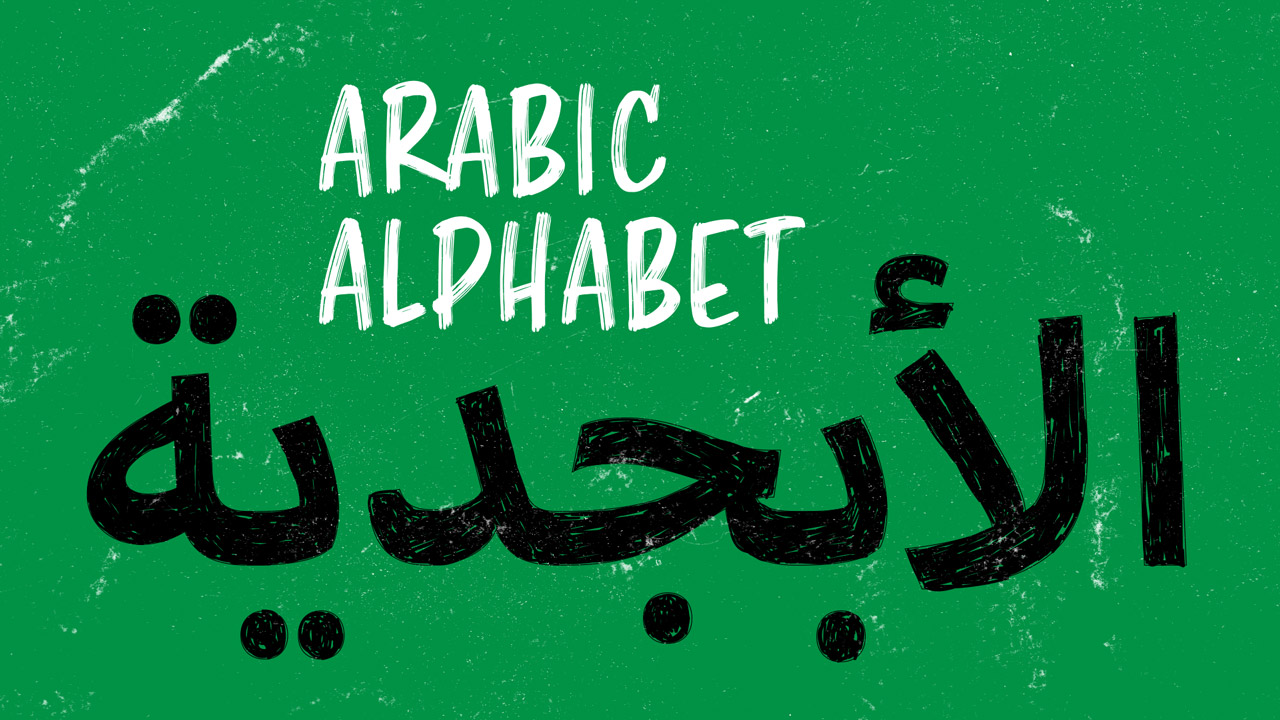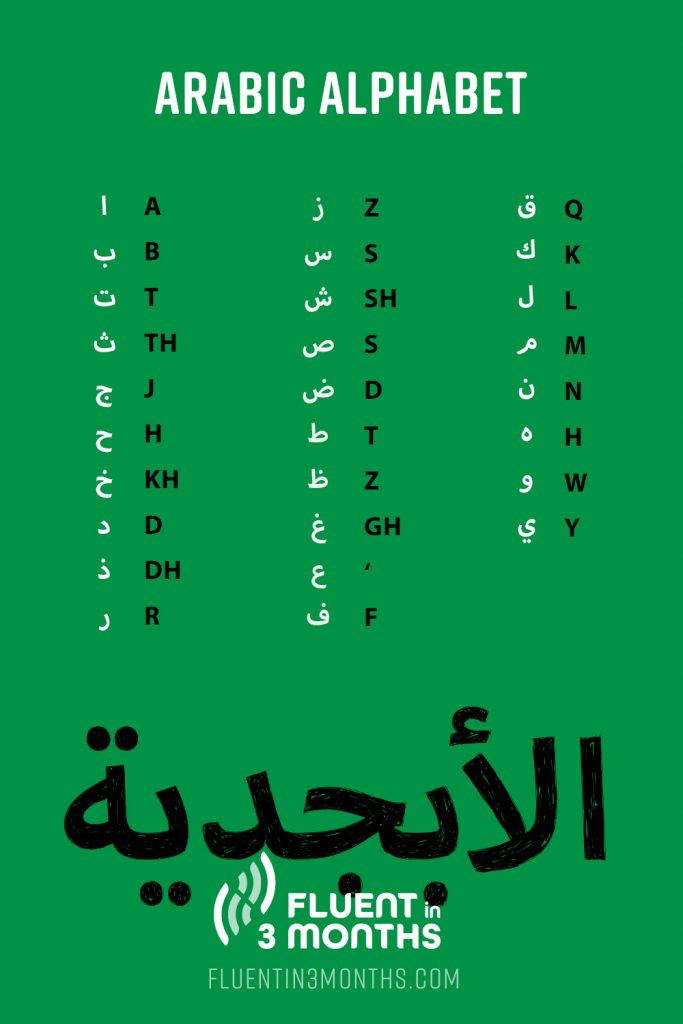Arabic Alphabet: The Guide to Learning the Arabic Letters and Script
There are various methods to learn the Arabic alphabet.
Most print courses give you a table of Arabic letters and then expect you to continue with the next lesson once you‘ve memorised the letters. This brute-force memorization method can be slightly improved if you use a spaced repetition flashcard system like Anki in order to study the letters one by one and review them at good intervals, but you’d still brutalise your brain to try to shove the Arabic letters in there.
In the end, even with perfect recall of the flashcards, you’d still be at risk of confusing the letters or simply not being able to string them together to read actual Arabic words. This blog post will try to answer the question of how you could learn the alphabet more intelligently and with less effort.
Table of contents
I’ll state right away that I’m not impartial, given that I have authored the book Arabic Script Hacking (and equivalent books for other alphabets) and I’d be happy for you to buy it. However, I am going to share a lot of tips that you can apply with or without the book.
1. Remembering the Basic Letters in the Arabic Alphabet
Problem: In Arabic, a lot of letters look similar to other letters, differing only by the number and position of dots. If you rely on rote memorization only, you‘ll inevitably confuse those similar letters.
Solution: Take advantage of the similarity! The Arabic alphabet is already grouped by similar shapes, so if you can find a mnemonic (a trick) that helps you remember the differences, you only need to learn very few distinct shapes.
For example, the Arabic equivalent of the letter T (ت) and the letter TH (ث) only differ by the number of dots. T has two dots and TH has three. This is perfect because the numbers two and three also start with T and TH respectively.
My suggestions for remembering the basic shapes:
| Arabic Letter | Transliteration | Mnemonic |
|---|---|---|
| ا | a | ‘alif looks like an actor standing tall and not allowing anyone to come near him. |
| ب | b | Baa looks like a Boat with a paddle in the water. |
| ت | t | Taa is also a boat, but with Two people in it. (You see their heads.) |
| ث | th | Thaa is also a boat, but with THree people inside. |
| ج | j | Jiim looks like an open Jaw with one big tooth. |
| ح | H | Haa is also a jaw, but one that is just a Hole, no teeth. |
| خ | kh | Khaa is also a jaw, but on top of it is a Hideous mole. |
| د | d | Daal has the same curve as the English letter D. |
| ذ | dh | Just as you’d expect Ď to not sound 100% the same as D, so adding a dot on top of Arabic Daal also changes its pronunciation – Dhaal with the dot sounds like the TH in ‘this’. |
| ر | r | Raa looks almost like the small English letter r, but upside down. |
| ز | z | Zay looks like a dolphin balancing a ball on its nose at the Zoo. |
| س | s | You’ll recognize Siin anywhere, because it has very distinctive waves like the Sea. |
| ش | sh | Shiin has the same waves, but this time there’s a Ship sailing on them. (Arabic speakers will often draw the three dots as a ^ rather than as individual dots, making it look even more like the sail of a ship.) |
| ص | S | Saad looks like a Snake. |
| ض | D | For Daad, the snake is eyeing a Duck that it wants to eat. |
| ط | T | Taa looks like a T-Rex. |
| ظ | Z | Zaa is the same T-Rex, now catching some zzz’s (sleeping). |
| غ | gh | Ghayn looks like a first grader tried to write the letter g and didn’t quite manage. |
| ع | ‘ | ‘ayn is the same but without the dot. |
| ف | f | Faa could be a Feather lying on the ground. |
| ق | q | Qaaf looks like a Quiver with two arrows sticking out of it. |
| ك | k | Kaaf looks like a Koala clinging to a tree. |
| ل | l | Laam looks like the English L, just mirrored. |
| م | m | Miim looks like a Mouse with a tail. |
| ن | n | Nuun is a Nose with a freckle. |
| ه | h | Haa looks like a Head. |
| و | w | Waaw looks like a Worm. |
| ي | y | Imagine Yaa as a water slide with two people going “Yaaay!” as they slide down and then land in the water beneath. |
2. Recognising the Initial, Medial and Final Shapes of Arabic Letters
It is not enough to study the letters as they are listed above because Arabic is always written in connected form (like the cursive you may have learned at school). It’s not optional like in English. And when the letters are connected, they necessarily take different shapes, usually abbreviated ones.
So apart from the shapes of the letters above, you’ll have to learn to recognize the ‘initial’, ‘medial’ and ‘final’ shapes of these letters, depending on whether the letters appear at the beginning, middle or the end of a word (or depending on circumstances that are too complicated for this post).
Before you complain: this is not too different from English. Consider that the capital letter A, which is used at the beginning of sentences, is also a different shape from the lower-case letter a. Many people in fact write “a” as “ɑ”, so that’s already three shapes one has to learn for the letter A, not counting cursive.
Problem: Arabic textbooks show you the different shapes that each letter will take, but they usually lack exercises. As long as your understanding remains theoretical, you will struggle with the Arabic alphabet.
Solution: In order to activate this knowledge of letter shapes, I recommend taking actual Arabic texts and not trying to read/understand them but just trying to find the letter. Counting how often the letter occurs in a text is an excellent way to train yourself to perceive Arabic differently.
3. Being Able to Pronounce Arabic
Problem: There are many Arabic letters whose pronunciation is unfamiliar and tricky.
Solution: First of all, I’d never buy any beginner-level course that doesn’t include audio. And by that I mean human audio, not computer voices (looking at you, Duolingo!), because I don’t want to sound like a robot.
Pronunciation is crucial to get right. But if you are stuck on the sound of a particular letter, you can find hundreds of audio examples at www.forvo.com.
There’s also a particular trick that linguists employ. That is to compare the pronunciation of two words that differ in only one letter, for example the English words bin and pin, in order to be able to zoom in on the difference.
4. Writing in Arabic Script
No matter how often you look at Arabic letters, you will find it very difficult to remember them unless you build a visceral relationship with the letters.
The easiest way to do so is to start meticulously copying Arabic by hand (remember to write right-to-left!). It‘s this way that you‘ll notice a lot of details that escape you by simply looking at the letters.
I recommend buying a set of writing exercise books for first graders, with multiple lines, which will help you match the relative size and bend of each letter part.
5. Developing Reading Fluency
In order to become as fluent reading Arabic letters as English letters, there is no way around lots of practice. However, as a beginner with a limited vocabulary, there is not much you can practice with.
If you keep reading your textbook dialogues, you will start to remember them, with barely a token effort to recognise and read the letters. There is also the danger that you may persistently misread words, because as a beginner you don‘t know if something should read kama or kana, katab or kathab, or similar.
Solution: Practice with words that should be familiar, such as country names, city names, personal names, words that Arabic borrowed from English, words that English borrowed from Arabic, and so on.
There are a lot of these words – several hundred, maybe a thousand – so that you don‘t easily run out of easy practice material, and at the same time you have an in-built self-correction system which makes you go “Wait a minute!” if you accidentally read Berlin as Bezlin.
To find suitable words, check the Arabic version of Wikipedia or google “Arabic words in English” or the like.
6. Combining Everything
When I was learning Arabic, I despaired with the available materials. Most of the language “courses” make zero effort to teach the alphabet. They really expect you to look at a table of letters and somehow cram it all into your brain.
So once I was further along, I set out to create an Arabic alphabet course that combines all these insights that I wish I would have had when starting out – the same insights that I outlined in this blog post.
My course introduces letters one by one, with mnemonics and references to similarities, with audio, with hundreds of cognates for your fluency practice, with space for writing and with letter search exercises for your recognition of different shapes.
You can assemble all this yourself from various sources on the internet based on the tips I gave above. But if you want to save those hours and spend them actually learning the language, or if you want to take advantage of the unique algorithm that ensures you‘re learning the letters in an optimal order and with maximum opportunities for practice, I would be very happy if you bought the book, Script Hacking Arabic by Judith Meyer.










Social